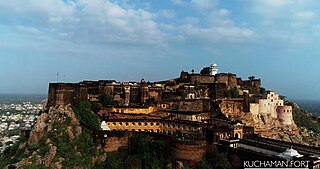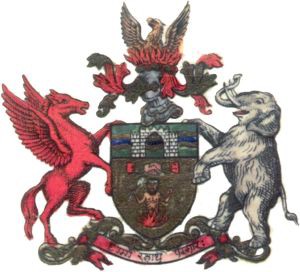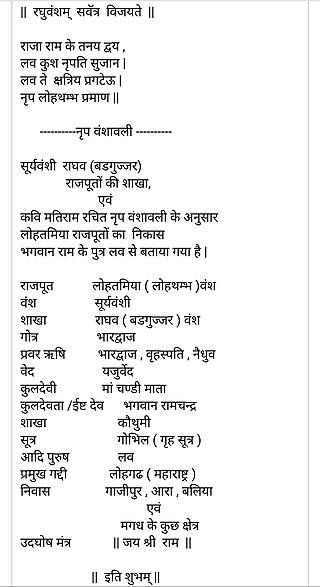
Ajmer is a city in the north-western Indian state of Rajasthan. It serves as the administrative headquarters of the Ajmer district and Ajmer division. It lies at the centre of Rajasthan, earning it the nickname 'the Heart of Rajasthan'.
Parmar, also known as Panwar is a Rajput clan found in Northern and Central India, especially in Rajasthan, Gujarat, Punjab, Haryana, Uttarakhand, Uttar Pradesh, Bihar, Jharkhand, Madhya Pradesh and North Maharashtra. The Panwar ruled in Ujjain and later in Dhar.

Chittorgarh is a major city in the state of Rajasthan in western India. It lies on the Berach River, a tributary of the Banas, and is the administrative headquarters of Chittorgarh District. It was a major stronghold of the Rajput State of Medapata. The city of Chittorgarh is located on the banks of river Gambhiri and Berach.
Bayana is a historical town and the headquarters of Bayana tehsil in Bharatpur district of Rajasthan in India. Hindaun City is nearest city of Bayana - 33 km. Bayana is also known as the city of 'Vansasur'. It was the site of famous Important Battle of Bayana in 1527 between Rajput ruler Rana Sanga ruler of Mewar and Mughal emperor Babur.
Muslim Rajputs or Musalman Rajpoots are the descendants of Rajputs in the northern regions of the Indian subcontinent who generally are followers of Islam. They converted from Hinduism to Islam from the medieval period onwards, creating various dynasties and states while retaining Hindu surnames such as Chauhan. Today, Muslim Rajputs can be found mostly in present-day Northern India and Pakistan. They are further divided into different clans.

Sheopur is a city in Madhya Pradesh state of central India. It is the administrative headquarters of Sheopur District. Sheopur is linked by narrow gauge rail to Gwalior(No longer in operation). The town is traditionally famous for its wood carving. Chambal River is just 25 km, which forms the boundary between Rajasthan and MP states.
Kishangarh Bas is a census town in Alwar district in the Indian state of Rajasthan. The Fort was built by Maharaja Surajmal. Kishan Singh who was an officer of Maharaja Surajmal of Bharatpur built the Kisheneshwar Temple inside the Fort.

Kuchaman City is a Municipal Council and District Headquarters of Didwana-Kuchaman District located in west-central Rajasthan, India. It is the largest city of newly Kuchaman district. The Didwana-Kuchaman district was carved out from the Nagaur District as the 38th District of the state of Rajasthan on 4 August 2023.
Sarwar is a city and a sub division in Ajmer district in the Indian state of Rajasthan. Additionally, it is a Nagar Palika and Panchayat samiti. It is part of the Kekri Assembly and Ajmer Lok Sabha constituencies. It was an independent State of Gaur Rajputs from 5th Century to till independence. One part of this family marched to Bihar region in 16th century and established many kingdoms,at present they are living in the Namudag estate fort.

The Jaunpur Sultanate was a late medieval Indian Muslim state which ruled over much of what is now the states of Uttar Pradesh and Bihar between 1394 and 1494. It was founded in 1394 by Khwajah-i-Jahan Malik Sarwar, an eunuch slave and former wazir of Sultan Nasiruddin Muhammad Shah IV Tughluq, amidst the disintegration of the Delhi Sultanate's Tughlaq dynasty. Centred in Jaunpur, the Sultanate extended authority over a large part of the Ganges-Yamuna Doab. It reached its greatest height under the rule of Sultan Ibrahim Shah, who also vastly contributed to the development of Islamic education in the Sultanate. In 1494, Sultan Hussain Khan was defeated by the forces of the Afghan ruler Bahlul Lodi, Sultan of the Lodi dynasty of the Delhi Sultanate at Benares at which point Hussain fled to Kahalgaon in modern-day Bihar where the Sultan of Bengal assigned him a pargana. Here he was allowed to mint his own coins and was promised help from Bengal in recovering his kingdom. He died in 1505.

Udai Singh, often referred as the Mota Raja was the Rathore ruler of Marwar, which was later known as Jodhpur. He was also the maternal grandfather of Shah Jahan, the fifth Mughal Emperor, and an ancestor of all subsequent emperors.

The history of human settlement in the western Indian state of Rajasthan dates back to about 100,000 years ago. Around 5000 to 2000 BCE many regions of Rajasthan belonged as the site of the Indus Valley Civilization. Kalibangan is the main Indus site of Rajasthan, here fire altars have been discovered, similar to those found at Lothal.

HH 108 Shri Maharajadhiraj Raj Rajeshwar Ravi Kula Bushana-Mahi Mahendra Yavadarya Kula Kamaldhivakara Chattis Rajkul Shringar Maharana Shri Sir FATEH SINGHJI Bahadur Hindua Suraj Hindupati, was the Sisodia Rajput ruler of the Princely State of Udaipur once known as Kingdom of Mewar for nearly 46 years from the year 1884 to 1930, with Udaipur as his capital, and resided in the grandiose City Palace, Udaipur.

The Ujjainiya or Ujjainia is a clan of Rajputs mainly found in Bihar and Purvanchal. They are an off-shoot of Paramara dynasty of Malwa. The Ujjainiya dynasty historically ruled over the parts of Bhojpuri region during the medieval era. They were mainly rulers and aristocrats holding major power of the region.
Maroth is a village located in Nawa, Nagaur district, in the state of Rajasthan, India. The area surrounding the village is named Gaurati, which means "The Land of Gaurs".

Hill Forts of Rajasthan are six forts, spread across Rajasthan state in northern India. They have been clustered as a series and designated as a UNESCO World Heritage Site in 2013. The hill forts series include—Chittor Fort at Chittorgarh, Kumbhalgarh Fort at Rajsamand, Ranthambore Fort at Sawai Madhopur, Gagron Fort at Jhalawar, Amer Fort at Jaipur and Jaisalmer Fort at Jaisalmer.

Namudag is a village and was a erstwhile princely state in the Chhatarpur Block, Palamu district, Jharkhand state, India. It is also known for the Garh of royal family of the Surwar rajput. Namudag princely state consist four zamindari estate Udai garh, Mahuari garh, Naudiha, Gulabjhari which were ruled by the members of the Namudag royal family.

Lohtamia is a sub-clan of Badgujar Rajputs They are old Suryavanshi Kshatriya and descendants of Lav, they are also known as The Lohtambh Bargujars. They migrated from Lahore and established their kingdom Lohgadh and in 11th century. They settled around gangetic area in Bihar and U.P. It is said that they were such a courageous Rajput community who never made any matrimonial alliances with the Mughals in order to save their daughters from the eyes of Muslim invaders, they went and settled on the banks of Ganga in Bihar.
Gaur also known as "Gour" is a Hindu Rajput clan of India. They have ancient ancestry and find mention by James Tod as one of 36 royal races in his book Annals and Antiquities of Rajasthan The Gaur Rajputs once held a prominent position in Ajmer till the time of Prithviraj Chauhan. Gorwar region gets its name from this clan. In later years they lost the territories ruled by them. In 15th century, they fought at least 13 battles with Shekhawats were defeated and were reduced to feudetory or jagirdars in Shekhawati region. The Rajgarh territory was one of the last bastion of Gaur Rajputs during the times of Mughal Emperors, Humayun and Akber, which was lost to Kishan Singh in 17th century. Gaur Rajputs remained allies to Mughal till the time of Aurangzeb, whose political decisions, alienated Rathods, Sisodias, Hadas and Gaur Rajput from Mughals.













